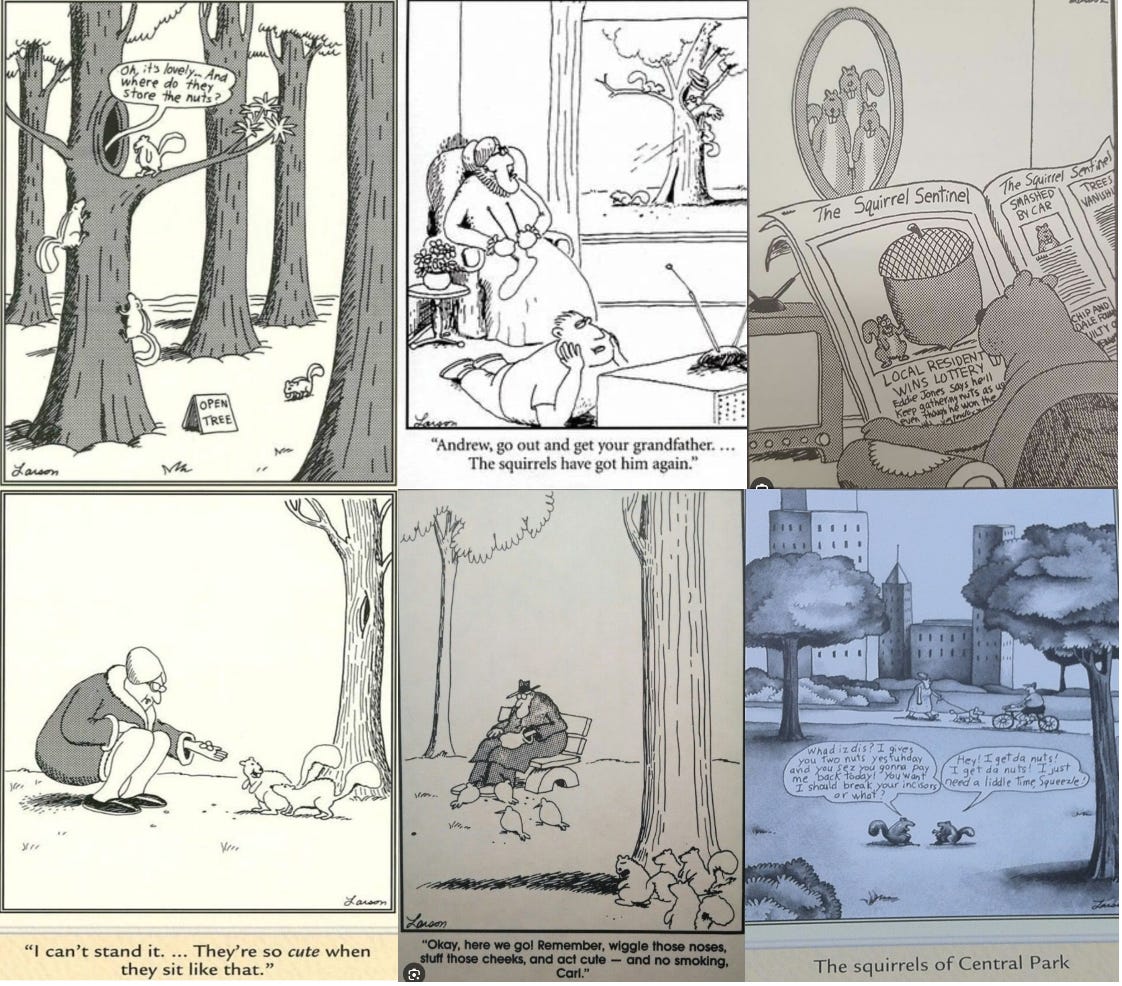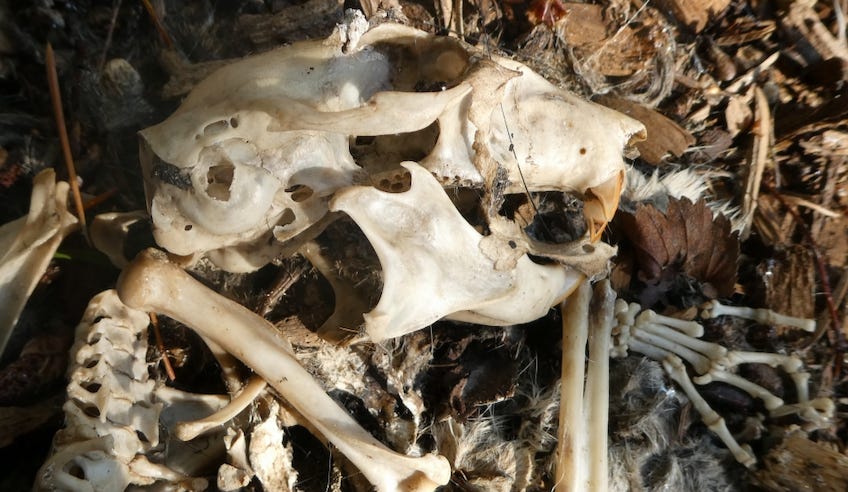The other day I found a dead body in our front yard. Well, actually it was the skeleton. About as long as a hardback book, it was under our native hawthorn, mostly intact, and looked as if the animal had lain down for a nap and simply died. Based on the skeleton’s size, the silver gray hair surrounding it, the front teeth (a pair of orangish incisors), and location (in our yard), I concluded that it was a squirrel, specifically an eastern gray squirrel (Sciurus carolinensis).
Ubiquitous, chatty, and agile, squirrels are probably the most commonly encountered non-pet mammal in Seattle, or most any other city. Why not? We provide great quantities of food, such as nuts, flowers, seeds, buds, catkins, and fruit, in addition to often feeding them. Backyard squirrels have relatively few urban predators, though our dog, Taylor, once brought in four baby squirrels, one at a time, seeming to want to share, or showoff, her hunting prowess. With our diverse yards, lawns, parks, empty lots, and other green spaces, we also provide many spots for them to cache food, which they bury by the gazillions and find by their noses and memories.
Despite their abundance, eastern gray squirrels are not native to Seattle. In the early 1920s, the Director of the Woodland Park Zoo had the brilliant idea that the little rodents should be let loose in Seattle because they “would be more attractive to visitors than the shy, unobstrusive, Douglas pine squirrel, which is native.” Following his directive, the city imported seven pairs of eastern gray squirrels from Minneapolis and released them in Woodland Park. They survived and thrived, and, as we all have experienced, spread widely, which unfortunately contributed to the displacement our native squirrels. Seattle is not alone in doing this; Philadelphians and many other east coast city dwellers began to capture and release eastern gray’s, as early as the 1840s, ultimately leading to their switch from a woodland beast to an urban one, sort of like us.
But back to the skeleton in our yard. Note the squirrel’s hand; you can clearly see the dexterous fingers, which enables them to hold their food and to cling to the various surfaces they so agilely encounter. Or look at the orangish incisors, which may look large but are actually relatively small considering that they grow continuously throughout an individual’s life; they are just an eighth of inch long because of regular gnawing. Also note the lower jaw, which is large in order to support the large muscles needed for their sundry urban diet.
Not that I seek out dead animals but I do generally take pleasure when I find one, particularly in our yard, much less so on the side of a road, where far too many die in their encounters with us and our vehicles. Being able to see the bones and teeth of the squirrel in our yard provided a wonderful opportunity to better understand the evolutionary adaptations that have allowed squirrels to thrive in the urban landscape. Plus, we rarely allow plants and animals to die naturally in cities; usually we remove their bones, bodies, and remains before they have a chance to decay and decompose before they disturb us, become a safety or health issue, or cause a ruckus. So am I rather pleased to let our dead squirrel live out his or her natural cycle of death and moulder back to his or her earthly rewards.
Word of the Week - Squirrel - Often attributed to the propensity to shade themselves with their tails, squirrel has a Greek origin, skia 'shadow' and oura 'tail.’ Squirrel has been an English term for hundreds of years (from Chaucer to Shakespeare to Eliot to Rowling) though the idea of squirreling something away for safekeeping didn’t first come into use until 1939. In that year, Ma Joad, through her creator, John Steinbeck, told her son Tom that she’d “been squirrelin’ money away,” before offering him seven dollars that she had saved.
“Squerels, and bestes smale of gentil kinde.” The Parlement of Fouls, Geoffrey Chaucer
“Ay, sir: the other squirrel was stolen from me by the hangman boys in the market-place: and then I offered her mine own, who is a dog as big as ten of yours, and therefore the gift the greater.” Two Gentlemen of Verona, Act IV, Scene IV, William Shakespeare (who I am told, despite what seems otherwise here, did know the difference between a dog and squirrel)
“If we had a keen vision and feeling of all ordinary human life, it would be like hearing the grass grow and the squirrel’s heart beat, and we should die of that roar which lies on the other side of silence. As it is, the quickest of us walk about well wadded with stupidity.” Middlemarch, George Eliot
“She’s nutty as squirrel poo.” Harry Potter and the Deathly Hallows, JK Rowling (I quite like the double meaning here.)
I like to think that I know Seattle and its streets pretty well but I am mere piker compared with my friend Austin Watson. He’s walked them all and then some. Here’s a delightful story about him. Keep on walking Mr. Watson.






Ack! I've fallen behind on my favorite newsletter! (Trips to admire the fossils in the limestone tiles of first floor Swedish Hospital Cherry Hill have been distracting me. Thanks again for the info about them!)
Interestingly, Bellingham has a genetic variant of gray squirrels that are black. Apparently this chacteristic spread from Canada and has become increasingly common in Whatcom County squirrels in the last 20 years. Evolution in action!
Thanks for all that you shared in this post. For some years I weekly used a crosswalk on a moderately busy street which happened to have a wire strung above it between 2 telephone poles. Invariably as I was waiting to cross, one or more squirrels would traverse the wire overhead. Pretty sure they were laughing at me, the dumb human who lacked the agility to do what they were doing. They really have no fear of heights. I often have seen them near the top of towering fir trees and sometime leaping between the trees! When one looks at those small hands, it is all the more amazing.
Enjoyed the KIRO audio about Austin Watson!